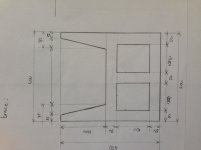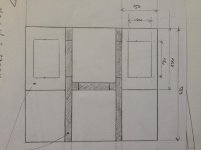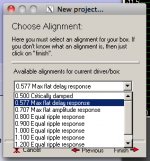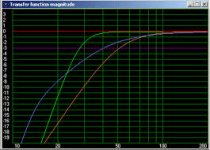Any thoughts comments on this design?
I keep reading and I keep learning. But since I'm new at loudspeaker design, all this information is difficult to process and difficult to put in to perspective. I keep reading that LF-efficiency is determined by Sd, box volume and Xmax. Since the ScanSpeak driver in my design reaches Xmax at 20Hz with as little as 23Watts, could it be that...
a) I've chosen the wrong driver/cabinet combination;
b) I need a totally different approach for what I hope to achieve?
What I hope to achieve is, in short: clean, powerful deep bass, to as low as 20Hz, quick and music-friendly reproduction, with good definition. Preferably not too large. I've no real preference for sealed or ported, as long as it's quick and does not "boom" or "smear".
Any thoughts/ideas are well appreciated. Thanks!
I keep reading and I keep learning. But since I'm new at loudspeaker design, all this information is difficult to process and difficult to put in to perspective. I keep reading that LF-efficiency is determined by Sd, box volume and Xmax. Since the ScanSpeak driver in my design reaches Xmax at 20Hz with as little as 23Watts, could it be that...
a) I've chosen the wrong driver/cabinet combination;
b) I need a totally different approach for what I hope to achieve?
What I hope to achieve is, in short: clean, powerful deep bass, to as low as 20Hz, quick and music-friendly reproduction, with good definition. Preferably not too large. I've no real preference for sealed or ported, as long as it's quick and does not "boom" or "smear".
Any thoughts/ideas are well appreciated. Thanks!
Besides the geometrical/mechanical/dimensions of your speaker what is the alignment?!Any thoughts comments on this design?
Let's compare:a) I've chosen the wrong driver/cabinet combination;
b) I need a totally different approach for what I hope to achieve?
What I hope to achieve is, in short: clean, powerful deep bass, to as low as 20Hz, quick and music-friendly reproduction, with good definition. Preferably not too large. I've no real preference for sealed or ported, as long as it's quick and does not "boom" or "smear".
Any thoughts/ideas are well appreciated. Thanks!
You need a sub with LF extension. Then you need a power sub, and more... you need small dimensions.
Let's check one 12" sub from DANLEY, would you like something like that (?) with smaller gross volume and lower LF extension. Well a little difficult but you have an idea, define your priorities.
Danley CS30 sub link pdf "The CS30 combines high sensitivity with very low frequency cutoff in a sub-compact package"
Gross: 141.58 liters/5 cubic feet
Range: 33Hz-67Hz (-3dB)
27Hz-150Hz (-10dB)
Take this one, with Eminence Lab 12C you have 20Hz (-8dB) with a small speaker sub 70/80L (net) tuned to 22Hz, 500W rms.
Eminence Lab 12C High Power 12" Subwoofer Speaker Driver 4 Ohm pdf
Eminence Lab 12C High Power 12" Subwoofer Speaker Driver 4 Ohm pdf
Other drivers of interest (eu)
Helix - Product Details
TIW 300 - 8 Ohm
D300 P04 ATOHM : NOTRE BUT ULTIME ... VOUS FAIRE VIBRER
AER Studiobass
Helix - Product Details
TIW 300 - 8 Ohm
D300 P04 ATOHM : NOTRE BUT ULTIME ... VOUS FAIRE VIBRER
AER Studiobass
Besides the geometrical/mechanical/dimensions of your speaker what is the alignment?!
Attachments
Seeing those other designs, I guess I'd rather go with eiter:
- an existing design;
- start from scratch;
- buy what I want from an audio store, pay way more than is justified and not learn anything.
So, just for educational purposes: what is wrong with my design? Why does the driver reach it's limits with so little power? Will I get useable 20Hz in-room extension without the Linkwitz EQ?
On the other hand: the 97dB my current design delivers at 20Hz will most likely be more than enough. I just wonder if what I'm doing is technically a poor design. I think that if I get it right, performance across the board will be so much better. And of course: limited size only goes so far if I really want truely deep bass, but I should specify that as "small footprint".
I've seen the Lab12 driver used quit a lot on this forum in bass applications. So I'm guessing it's a lot of bang for the buck and easy to use. I've also read here that a tapped horn design can perhaps deliver what I need with a relatively small driver (also the Lab12C). But the cabinet will still be quite large. Don't you just hate the WAF..?? And how will that integrate with pretty conventional ported mini-monitors (Dynaudio Special 25)? I suppose a continuous phase control may be able to help there.
And how will that integrate with pretty conventional ported mini-monitors (Dynaudio Special 25)? I suppose a continuous phase control may be able to help there.
The Danly CS30 confuses me. They claim to present real-world and repeatable measurements. All fine. Then they say the CS30 is the smallest commercially available sub that's able to produce 30Hz. I know that's not true. My own sub is smaller and it produces 25Hz. Not at 120+ dB - granted. But I doubt the CS30 manages 30Hz at 121 dB from a 12" driver. 121dB is LOUD!! And 30Hz is not that low. If it does: how can it produce such levels at those frequencies? I suppose the horn-tuning has something to do with that (enhancing efficiency at a certain (resonant) frequency)? So, obtaining even lower frequencies will mean exponentially larger drivers and cabinets and more power to drive it all, I guess.
Getting confused....

- an existing design;
- start from scratch;
- buy what I want from an audio store, pay way more than is justified and not learn anything.
So, just for educational purposes: what is wrong with my design? Why does the driver reach it's limits with so little power? Will I get useable 20Hz in-room extension without the Linkwitz EQ?
On the other hand: the 97dB my current design delivers at 20Hz will most likely be more than enough. I just wonder if what I'm doing is technically a poor design. I think that if I get it right, performance across the board will be so much better. And of course: limited size only goes so far if I really want truely deep bass, but I should specify that as "small footprint".
I've seen the Lab12 driver used quit a lot on this forum in bass applications. So I'm guessing it's a lot of bang for the buck and easy to use. I've also read here that a tapped horn design can perhaps deliver what I need with a relatively small driver (also the Lab12C). But the cabinet will still be quite large. Don't you just hate the WAF..??
The Danly CS30 confuses me. They claim to present real-world and repeatable measurements. All fine. Then they say the CS30 is the smallest commercially available sub that's able to produce 30Hz. I know that's not true. My own sub is smaller and it produces 25Hz. Not at 120+ dB - granted. But I doubt the CS30 manages 30Hz at 121 dB from a 12" driver. 121dB is LOUD!! And 30Hz is not that low. If it does: how can it produce such levels at those frequencies? I suppose the horn-tuning has something to do with that (enhancing efficiency at a certain (resonant) frequency)? So, obtaining even lower frequencies will mean exponentially larger drivers and cabinets and more power to drive it all, I guess.
Getting confused....
Last edited:
Looking at my current design, would a driver with a (much) larger Xmax be of any help (box design identical)? For example the Aurasound NS12-794-4A? Don't know what is costs, exactly. But I've read it's expensive. Such a driver requires a top-notch design, of course. It would be a waste of money to experiment with it and learn along the way.
At http://www.diyaudio.com/forums/subwoofers/62267-modeling-room-gain.html paulspencer says "I've seen a few different theoretical "room gain curves" with a nice neat curve... But when you see measurements from a real room you realise how pointless it is considering this curve. Add to your curve a 20 db peak at 35 Hz, then a 15 db dip at 55 then numerous peaks and dips between there and 200 Hz. It becomes difficult if not impossible to say if there is actually any gain now. If you eq out the lowest dip, you then find that your sub that is flat to 20 Hz anechoic now needs 12db of eq to reach 20 Hz flat in room! The room modes dominate. "
So I think you have to decouple the topic of speaker response and room response somewhat. The speaker response to me is more about the sound-boomy versus tight, and a slow rolloff sounds better, and the -3 dB point does not matter very much. There is NOTHING magic about -3 dB! It was just a mathematical convenience for Richard Small's thesis. The -6 dB and -10 dB points are more important. All this leads to my preference for "undertuned" ported boxes (or sealed, but sealed just gives up a lot of output subwoofer situations, so you need special drivers and BIG amps)
[...]
By the way, it's been a long time, but we had tested and sold Dynaudio drivers back when Morel was part of that. The conclusion of a number of us speaker engineers, and results from the field, was that the drivers seemed great for high dynamic power, but simply did not stand up to constant pounding. 1812 Overture, yes. Motorhead, no. Not sure if I would rank Scan-Speak as better in that regard or not.
I'm very picky about boomy bass, too. So I'm looking into a sealed design (small group delay is also nice). But I'm not familiar with underported designs. Can you elaborate a little?
And about driver choise for subwoofer duty: how would you classify the AuraSound NS12-794-4A (except "expensive")? I think it might better fit my sealed design, because of it's high Xmax. That way I would not be in danger of damaging the driver any time soon.
It does seem like a very capable driver. I've seen prices quoted in the $500,- range. That would translate to some €400 - €450,- euro's, which doesn't sound all that bad. I'm not sure what the driver costs on the European main land, if it can be obtained at all.
I've modeled it in a 94l sealed enclosure (Qtc=0,59 or so), with a linkwitz transform (f3=20Hz). It manages more than a 110dB (200watts) at that frequency! Which is rediculous! I don't think I need that much power, though it's certainly good to have the headroom available. I may not need the extension, either (room gain, etc). In contrast, the ScanSpeak maxes out at 23 Watts at 20Hz... Both drivers should cost more or less the same. It I gen get it...
Would it be a good idea to first build a cheap mock-up from fibre board with a cheaper driver, to get an idea of the performance?
I've modeled it in a 94l sealed enclosure (Qtc=0,59 or so), with a linkwitz transform (f3=20Hz). It manages more than a 110dB (200watts) at that frequency! Which is rediculous! I don't think I need that much power, though it's certainly good to have the headroom available. I may not need the extension, either (room gain, etc). In contrast, the ScanSpeak maxes out at 23 Watts at 20Hz... Both drivers should cost more or less the same. It I gen get it...
Would it be a good idea to first build a cheap mock-up from fibre board with a cheaper driver, to get an idea of the performance?
Last edited:
Oh, I hadn't seen that. I worked with the 1808-one was on eBay for $500 but sold already.AuraSound NS12-794-4A
Very nice (reflex), can you buy it? Nice simulation 20Hz (-7dB)
Do you access to it?!
I'm very picky about boomy bass, too. So I'm looking into a sealed design (small group delay is also nice). But I'm not familiar with underported designs. Can you elaborate a little?
Well, it would be better if I had a simulator to make curves, but I don't have anything handy. See the graphic I found online. The red curve I suppose is sealed. The green curve might be a "maximally flat" QB3, or at least let's pretend so. Let's pretend it is tuned to 32 Hz. Well, what happens if we tune lower? The initial rolloff is slower, and there is less SPL right around above the QB3 F3 (because the port is now tuned lower and is not reinforcing those frequencies). However, there is more output below that (down where the port is now tuned). And the group delay at those frequencies is usually less.
If you tune the port TOO low, you'll get a peak down low and ugly group delay. The attached curve doesn't do that, but looks a bit too much under tuned. But at least you can get the general idea.
Attachments
Last edited:
So, basically, undertuning means tuning the port slightly lower than the tuning for maximum flat output? This should result in a slightly gentler roll-off, thus a little greater extension - correct? I think I'll have to mess around with a few models to see it's effect on the different aspects of a system's behaviour. Is it in any way comparable to the use of a passive radiator?
Yes!So, basically, undertuning means tuning the port slightly lower than the tuning for maximum flat output? This should result in a slightly gentler roll-off, thus a little greater extension - correct?
No!Is it in any way comparable to the use of a passive radiator?
A passive radiator is just a different version of a port. They both are modeled by a mass sitting on a spring. The air in the port is the mass in the ported case; the mass of the cone is the mass in the PR case. The "spring" is the air in the box.
Passive radiator advantages include the possibility to have a "ported" box for cases where a big enough port will not physically fit, and (depending on the cone) reduced radiation of sound from inside the enclosure. Limitations can be excursion, linearity, and some minute funniness of response that I don't recall exactly from reading a paper about it long ago.
@ Jamesblond,
Bit of a thread resurrection,
Did you go with the scanspeak 32W in the end? How did it turn out if you did?
I have one on order, should arrive next week, my 3rd MiniDSP 2x4 also incoming (Cant praise these enough, Wonderful bit of kit)
Was also thinking of around 94Litre sealed box for mine
Bit of a thread resurrection,
Did you go with the scanspeak 32W in the end? How did it turn out if you did?
I have one on order, should arrive next week, my 3rd MiniDSP 2x4 also incoming (Cant praise these enough, Wonderful bit of kit)
Was also thinking of around 94Litre sealed box for mine
I went with two 41 liter sealed boxes, a Peerless XXLS 12 p830844 in each. Each cabinet contains a Hypex PSC2.400, using only one of the two channels.
I’ve measured my room and, as a first step, tamed room modes with sharp notch filters.
The result is stunning, deep bass with power, agility and slam, down to well below 18Hz in room. I couldn’t be more happy with how it turned out. I may try to post a picture later.
I’ve measured my room and, as a first step, tamed room modes with sharp notch filters.
The result is stunning, deep bass with power, agility and slam, down to well below 18Hz in room. I couldn’t be more happy with how it turned out. I may try to post a picture later.
- Status
- This old topic is closed. If you want to reopen this topic, contact a moderator using the "Report Post" button.
- Home
- Loudspeakers
- Subwoofers
- I'd like some pointer on an idea for a 12" sub - Morel or ScanSpeak



